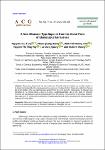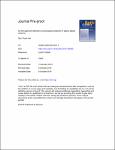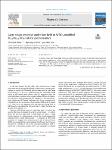Search
Author
- Anh-Tuan Le (14)
- Quan-Hoang Vuong (14)
- Ngo, Xuan Dinh (11)
- Tuan Q. Do (10)
- next >
Subject
- Electrospinning (7)
- Nanoparticles (6)
- Machine learning (5)
- Compound droplet (4)
- next >
Date issued
Has File(s)
Search Results
Sustained microglial activation and increased pro-inflammatory signalling cause chronic inflammation and neuronal damage in Alzheimer’s disease (AD). Resolution of inflammation follows neutralization of pathogens and is a response to limit damage and promote healing, mediated by pro-resolving lipid mediators (LMs). Since resolution is impaired in AD brains, we decided to test if intranasal administration of pro-resolving LMs in the AppNL-G-F/NL-G-F mouse model for AD could resolve inflammation and ameliorate pathology in the brain. A mixture of the pro-resolving LMs resolvin (Rv) E1, RvD1, RvD2, maresin 1 (MaR1) and neuroprotectin D1 (NPD1) was administered to stimulate their respective receptors. We examined amyloid load, cognition, neuronal network oscillations, glial activation a... |
Long-lived particles that are present in many new physics models beyond the standard model, can be searched for in a number of newly proposed lifetime frontier experiments at the LHC. The signals of the long-lived dark photons can be significantly enhanced in a new dark photon model in which dark photons are copiously produced in the hidden radiation process. We investigate the capability of various lifetime frontier detectors in probing the parameter space of this model, including the far forward detectors FACET and FASER, the far transverse detector MATHUSLA, and the precision timing detector CMS-MTD. |
GldL is an inner-membrane protein that is essential for the function of the type IX secretion system (T9SS) in Flavobacterium johnsoniae. The complex that it forms with GldM is supposed to act as a new rotary motor involved in the gliding motility of the bacterium. In the context of structural studies of GldL to gain information on the assembly and function of the T9SS, two camelid nanobodies were selected, produced and purified. Their interaction with the cytoplasmic domain of GldL was characterized and their crystal structures were solved. These nanobodies will be used as crystallization chaperones to help in the crystallization of the cytoplasmic domain of GldL and could also help to solve the structure of the complex using molecular replacement. |
Ultrasound viscoelastography is a quantitative and convenient imaging model that images soft tissues based on shear waves’ propagation. Thanks to the interaction between ultrasonic waves and shear waves, the physical features of soft tissues (elasticity, viscosity) are expressed by complex shear modulus (CSM) parameters, useful information for diagnosing tissue medical states. Therefore, this paper presented a new efficient approach to estimate CSM and reconstruct the viscoelastic images. |
Radiotherapy (RT) followed by radical surgery is an effective standard treatment strategy for various types of cancer, including rectal cancer. The response to RT varies among patients, and the radiosensitivity of cancer cells determines the clinical outcome of patients. However, the application of RT to patients with radioresistant tumors may result in radiation‑induced toxicity without clinical benefits. Currently, there are no effective methods to predict the response to RT. The limitations of the methods currently used to evaluate tumor radiosensitivity, which are mainly based on clinical and radiological features, are low sensitivity and specificity. Non‑coding RNAs (ncRNAs) have emerged as a class of biomarkers for predicting radiosensitivity. In particular, the expression pat... |
Elaeocarpus hainanensis has been used in the Oriental medicine but there are very few studies on its phytochemical profile. Our ongoing research on chemical constituents from Elaeocarpus plants in Vietnam led to the isolation of a new oleanane-type saponin from the aerial part of E. hainanensis. Its structure was identified as 1α-hydroxy-olean-11-oxo-12-en-3-O-β-L-arabinopyranoside (1) on the basis of extensive chemical and spectroscopic analyses including NMR and MS spectra. The occurence of the unique oleananetype saponins in E. hainanensis contributed to impact phytochemical profile associated with chemotaxanomy meaning of the title plant. |
We argue that neutrino mass and dark matter can arise from an approximate B − L symmetry. This idea can be realized in a minimal setup of the flipped 3-3-1 model, which discriminates lepton families while keeping universal quark families and uses only two scalar triplets in order for symmetry breaking and mass generation. This proposal contains naturally an approximate non-Abelian B − L symmetry which consequently leads to an approximate matter parity. The approximate symmetries produce small neutrino masses in terms of type II and III seesaws and may make dark matter long lived. Additionally, dark matter candidate is either unified with the Higgs doublet by gauge symmetry or acted as an inert multiplet. The Peccei-Quinn symmetry is discussed. The gauge and scalar sectors are exactl... |
Elastic optical networks technologies feature several benefits including higher spectral efficiency, system capacity and therefore have been widely viewed as the promising paradigm for next-generation optical transport networks. Dedicated path protection for elastic optical networks has been of ever-increasing importance in the era of information society thanks to its near-immediate recovery speed and remarkably simple operations in guaranteeing the connectivity of information flows. Inspired by the observation that the today premium network traffic traveling in fiber links accounts for roughly 25% of total traffic and the best-effort traffic constitutes the remaining, we propose a new design for elastic optical networks with dedicated path protection tailoring to the actual traffic... |
Các màng quang xúc tác hỗn hợp Zn1 − xSnxO NR / ITO được chế tạo bằng phương pháp thủy nhiệt. Nồng độ Sn dopant trong nanorods Zn1 − xSnxO (NR) thay đổi từ 0% đến 7%. Các đặc điểm hình thái cấu trúc và bề mặt của màng quang xúc tác hỗn hợp Zn1 − xSnxO NR / ITO đã được nghiên cứu bằng nhiễu xạ tia X (XRD) và kính hiển vi điện tử quét (SEM), tương ứng. Ngoài ra, tính chất xúc tác quang của vật liệu tổng hợp được đánh giá bằng tốc độ phân hủy của dung dịch nước Rhodamine-B dưới bức xạ tia UV. Kết quả SEM chỉ ra rằng, với nồng độ Sn dopant ngày càng tăng trong Zn1 S xSnxO NR / ITO, diện tích bề mặt hiệu quả đã bị suy giảm do chức năng phân rã theo hàm mũ và mức giảm không đáng kể vì nồng độ pha tạp Sn cao hơn 3%. Với sự tương đồng về diện tích bề mặt hiệu quả, sự đóng góp của Sn trong v... |
To further reduce the driving field of Bi1/2Na1/2TiO3-based piezoceramics to meet the requirements for real actuators applications, SrTiO3 modified 0.99Bi1/2Na1/2TiO3-0.01LaFeO3 piezoceramics were synthesized. The 0.79Bi1/2Na1/2TiO3-0.01LaFeO3-0.20SrTiO3 provides the large electrostrains of 405 pm/V at 1.7 kV/mm and 565 pm/V at 2 kV/mm, which are triable values for actuator applications in non-textured Bi1/2Na1/2TiO3-based piezoceramics. |






